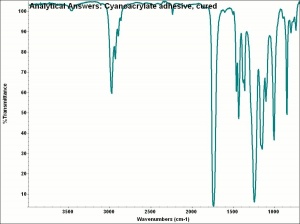Difference between revisions of "Cyanoacrylate resin"
| Line 9: | Line 9: | ||
== Applications == | == Applications == | ||
[[[SliderGallery rightalign|aaiCYANOacrylate.jpg~FTIR]]] | [[[SliderGallery rightalign|aaiCYANOacrylate.jpg~FTIR]]] | ||
| − | |||
* Adhesive | * Adhesive | ||
Revision as of 08:36, 2 July 2020
Description
A thermoplastic polymer commonly used as a fast-setting, strong adhesive. The first cyanoacrylate adhesive was made in 1941, but not marketed till 1958 as Eastman 910® [Eastman Kodak]. Cyanoacrylate adhesives are based on ethyl-2-cyanoacrylate polymers. Most commercial formulations also contain stabilizers, thickeners and catalysts. The glues set rapidly (5 seconds - 3 minutes) upon exposure to ultraviolet radiation or moisture. When cured, they form an extremely strong bond that is fairly insoluble. Cyanoacrylate glues has been used for gluing glass, ceramics and other hard materials. They also have medical and dental applications to suture skin and weld crowns. Some cyanoacrylate glues may lose adhesive strength with time. Ultraviolet light and contact with alkaline materials (glass and some stones) will accelerate the degradation process.
Synonyms and Related Terms
CA; super glue; instant adhesive; Super Glue Gel [Loctite]; Krazy® glue [Borden]; Super Attack [Loctite]; Zap; Eastman 910® [Eastman Chemical]; ELFY® super glue; ethyl cyanoacrylate; Dermabond; Traumaseal; cianoacrilati (It.); cyanoacrylaat (Ned.); resina de cianoacrilato (Esp.)
Applications
- Adhesive
Risks
May cause irritation to skin and eyes. Will adhere objects on contact, including skin. Flash points range from 75-80°C.
Physical and Chemical Properties
Uncured glue soluble in acetone, methanol, toluene, MEK. Cured glue is slightly soluble in DMF or nitromethane. Soaking in acetone may decrease adhesion and cause the join to separate.
| CAS | 7085-85-0 |
|---|---|
| Density | 1.05-1.10 |
Additional Information
° H.W.Coover, J.M.McIntire, "Cyanoacrylate Adhesives" in Handbook of Adhesives, I.Skeist (ed.), Van Nostrand Reinhold, New York, 1977, p.569-580.
° Website: www.speedline.ca/edavidson/cyanoacrylates.html
Comparisons
Physical Properties for Selected Thermoplastic Resins
General Characteristics of Polymers
Sources Checked for Data in Record
- Theodore J. Reinhart, 'Glossary of Terms', Engineered Plastics, ASM International, 1988
- Richard S. Lewis, Hawley's Condensed Chemical Dictionary, Van Nostrand Reinhold, New York, 10th ed., 1993
- Michael McCann, Artist Beware, Watson-Guptill Publications, New York City, 1979
- Irving Skeist, Handbook of Adhesives, Van Nostrand Reinhold Company, New York, 1977
- Wikipedia, the free encyclopedia, at http://www.wikipedia.com Comment: http://en.wikipedia.org/wiki/Cyanoacrylate (Accessed Feb. 10, 2006)
